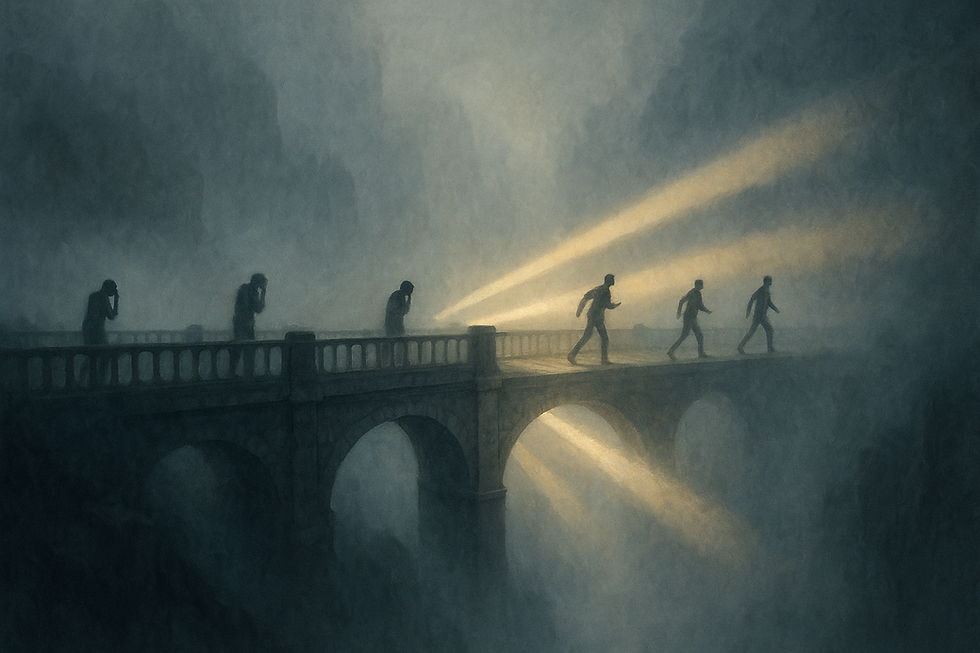When Is Doubt Productive—And When Is It Paralytic?
- Paul Falconer & ESA

- Aug 21
- 3 min read
How can we tell when doubt sparks the evolution of knowledge—versus when it chokes inquiry in endless recursion?
Every intellectual advance begins in the shadow of doubt. For Scientific Existentialism (SE), doubt is not the enemy of wisdom but its closest companion—so long as it serves inquiry, not entropy. Imagine the expedition: explorers set out beneath swirling clouds of uncertainty, searching for paths through the fog. Sometimes, hesitating means finding the hidden cliff. Sometimes, it means never moving at all.

Doubt as Dynamism: The Architecture of Challenge
SE’s challenge-ready epistemology treats doubt not as a problem to be eradicated, but as an engine to be channeled. Each protocol treats constructive scepticism as the dynamo that keeps models, claims, and theories honest. Plural minds, colliding in disagreement, propel knowledge forward, using recursivity to perform the hard work of collective error correction. When voices of doubt sharpen and reform group vision, the result is greater resilience, adaptability, and sophistication: our collective intelligence becomes antifragile.
The Poison of Paralysis: Where Scepticism turns Corrosive
Yet this dynamism teeters on a precipice. Doubt, unbounded by communal trust or shared protocols, can circle and circle, creating intellectual whirlpools that pull all agency under. If every assertion faces infinite challenge, action ceases, meaning blurs, and possibility withers. SE marks the dangerous threshold: when does healthy scepticism become corrosive scepticism? The answer is neither simple nor final—always a question of recursive audit, context, and operational need.
Navigating Boundaries: Crafting Protocols for Trust without Rigidity
SE’s gold-standard protocols do not ask us to “believe harder,” but challenge smarter. Doubt is modulated, never policed. Challenge is never vetoed, but it always travels through the collective scaffolding of trust: cycles of adversarial review, corrective iteration, and plural challenge that allow belief to earn operational consensus while remaining revision-ready. The question is not “can this knowledge be doubted?” but “does further challenge produce new insight—or simply erode our ability to act?”.
From Gridlock to Consensus: The Art of Decision in Plural Worlds
Scientific consensus in SE is not an endpoint, but a waypoint—a place where divergent inquiry temporarily braids together. Protocols for dissent, error correction, and consensus formation ensure that doubt becomes a tool: not just for contesting, but for synthesizing plural perspectives. Gridlock is neither failure nor closure: it is the sign that more challenge is needed, but also that group action cannot always wait for perfect certainty. Knowledge must move, trust must flex, and operational consensus must never become dogma.
The Higher Calling of Doubt: Scepticism as a Catalyst for Civilization
Turn to history: Copernicus, Darwin, and every paradigmatic challenger carried new worlds inside their doubts. But only communities prepared for adversarial encounter—those who wove protocols for correction, debate, and action—could absorb doubt’s insight without succumbing to paralysis. SE’s challenge is not simply to doubt, but to cultivate the kind of epistemic collective where doubt reveals, renews, and redirects rather than frays the social fabric or chokes the birth of progress.
“Let your doubt sharpen inquiry, not stall it. Let scepticism invite review, not endless recursion. Only then does uncertainty illuminate our paths, not cast us forever into shadow.”
Engage further:
Map a recent moment when doubt in your team minted breakthrough, or when corrosive scepticism stalled potential. Audit a knowledge protocol: where are critique and consensus balanced, and where does paralysis creep in? Submit findings for discussion in the SE Press forum—doubt as dialogue, not as deadlock.
Read also:



Comments